#russian imperial wedding
Photo

✵ November 9, 1866 ✵
Princess Maria Dagmar of Denmark & Grand Duke Alexander Alexandrovich
Later Tsar & Tsarina of Russia
#Russia#Russian Royal Family#russian orthodox#russian imperial family#russian imperial wedding#Royal Wedding#danish royal family#danish royal wedding#danish royalty
18 notes
·
View notes
Text

Before the Wedding, Firs Zhuravlyov. 1870s.
#aesthetic#art#art history#fashion#historical fashion#historical art#women in art#women#victorian#victorian aesthetic#1870s#1870s aesthetic#genre painting#Russian art#Russian history#imperial Russia#wedding#genre#wedding art#red#red aesthetic#1870s wedding#1870s dress#1870s gown
308 notes
·
View notes
Text
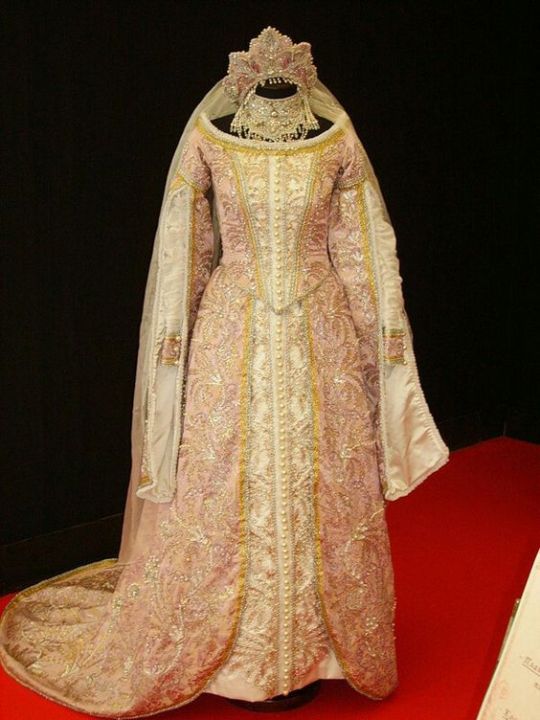
link
formal court ensemble for Rhaena
#hotd#rhaena of pentos#Rhaena hightower#or a wedding ensemble to Aemond#I really like Imperial Russian for Targaryen court dress#me giving Rhaena the wardrobe she deserves
7 notes
·
View notes
Text

Imperial Weddings during the Romanov Reign
The bridal ensemble of a Romanov imperial bride was always the same. It could not deviate from the regulations estipulated by the imperial code. They wore dresses made of cloth of silver or gold, with jeweled buttons down the skirt, topped by a velvet and ermine mantle.
Their diamond accessories included the grand tiara made for Empress Elizabeth, which featured the Paul I Pink Diamond, as well as the Nuptial Crown, the Cherry Earrings, the Diamond Necklace, the Diamond Bracelet, and the Cloak Clasp, which had been made for Catherine the Great. A royal wedding outfit weighed 25-30 kg. Standing still in it all day was difficult, let alone moving around! Sometimes the exhausted brides had to be carried.
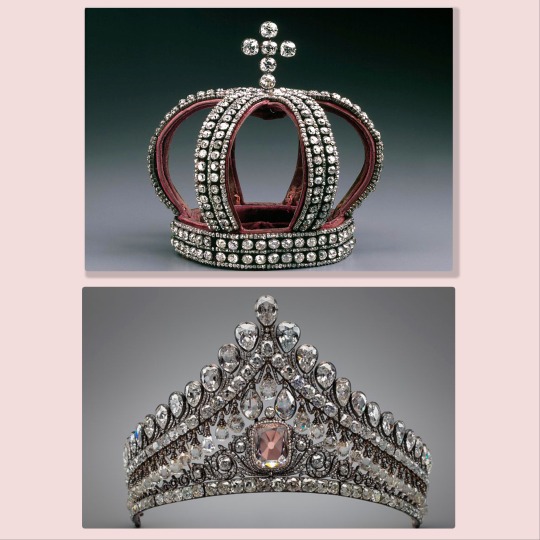

According to tradition, brides in the Romanov family donated their wedding dresses to the church afterward. However, Alexandra Feodorovna, the last empress of Russia, decided to keep hers. That is why her wedding dress has survived to this day (it is on exhibition in the Hermitage.) This was considered an omen of bad luck.
Since Queen Victoria could not attend the wedding of her beloved granddaughter Alix in Russia, her other granddaughter, Alexandra's sister, Grand Duchess Elizabeth Feodorovna, sketched Alix’s wedding dress without the jewels and the velvet cloak and sent the sketch to their grandmother with a letter. In the letter, she discusses the lace veil worn by Alix as her bridal veil. It was the same lace wedding veil worn by her mother, Princess Alice of the United Kingdom, and her sisters, Princess Victoria, Grand Duchess Ella, and Princess Irene. See the sketches below.


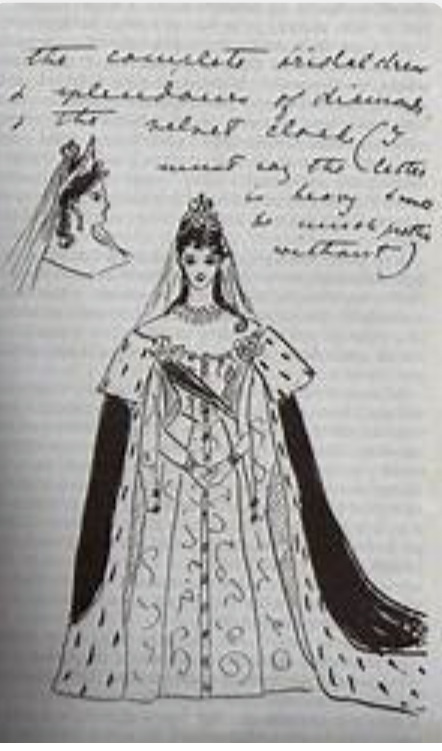
Towards the end of the Romanov tenure as rulers of Russia, regulations relaxed somewhat. Nicholas II's sister Olga, who was notoriously rebellious regarding protocol, did not conduct her first wedding according to the imperial code and wore a regular wedding dress and none of the jewels. Her second wedding years later was even more casual. Prince Marie of Greece and Denmark (to become Grand Duchess Marie Georgevna by marriage) refused to get married in Russia or wear the wedding regalia, although she wore Russian court dress. The tradition had been for all imperial women to marry at the chapel in the Winter Palace, and it was not broken even for Queen Victoria, who could not travel so far by the time her second son, Prince Alfred Ernest, married Grand Duchess Maria Alexandrovna, the daughter of Emperor Alexander II.

#Grand Duchess Olga Alexandrovna#Grand Duchess Xenia Alexandrovna#Empress Alexandra Feodorovna#Grand Duchess Marie Georgievna#Grand Duchess Maria Palvolvna the Younger#Grand Duchess Helena Vladimirovna#Grand Duchess Elizabeta Mavrikievna#Grand Duchess Maria Alexandrovna#imperial art#imperial weddings#russian history#imperial russia#Romanov family#Romanov wedding jewels
12 notes
·
View notes
Text
Alexandra Feodorovna’s Wedding Dress

“Her wedding dress was a magnificent creation; the outfit was so intricate that it took nearly an hour for Alexandra to dress. Her stockings were of lace, her shoes embroidered and decorated. Over these she wore layers of stiff petticoats. The wide, full skirt of silver brocade opened from the waist down to reveal a second underskirt of silver tissue, edged with fur. The décolletage was cut low, to reveal the neck and shoulders, and the gown had short sleeves trailing ermine-edged tippets. The tightly fitted, boned bodice was sewn with diamonds which sparkled with every move. The folds of the overskirt fell back to form a train, and a separate, sweeping court train of cloth-of-gold edged with ermine fell from her shoulders. Over this, Alexandra wore the imperial mantle of cloth-of-gold, lined and edged with ermine. These robes were so heavy that four pages had to help carry them.
Alexandra wore her hair swept back to emphasise her graceful neck and shoulders. Two long, twin side curls were attached to her own hair. Her long veil of tulle was held in place by a Russian Kokoshnik tiara, of diamonds set in platinum, and the Romanov nuptial crown of diamonds sewn on crimson velvet. Alexandra also wore a number of diamond brooches on the front of her gown, along with the jewelled chain of the Order of St. Andrew and strings of pearls around her neck. These jewels, as well as the tiara, had been wedding gifts from the late tsar, costing some 300,000 rubles ($150,000). She also wore the imperial riviére, a diamond necklace of 475 carats, and a pair of matching earrings. The earrings were so heavy, in fact, that they had to be supported by wires around the ears, which slowly cut into the flesh as the day wore on. Around her tiara, Alexandra wore a wreath of orange blossoms, brought from the Imperial Conservatory in Warsaw. Across the dress stretched the red ribbon of the Order of St. Catherine.”
[Greg King, The Last Empress: The Life and Times of Alexandra Feodorovna, Tsarina of Russia]
144 notes
·
View notes
Text

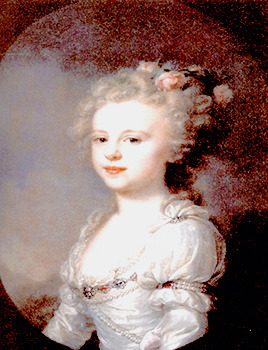

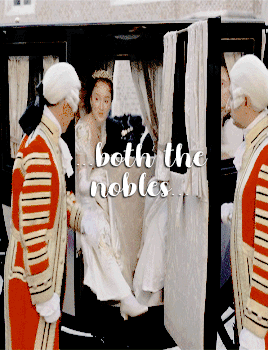
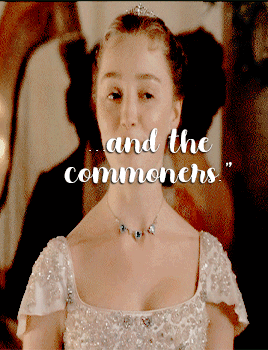
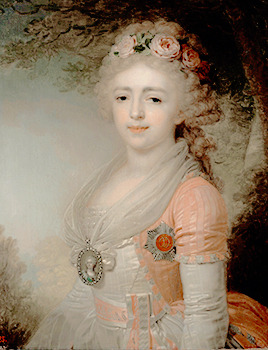
"In 1799, three years after her failed betrothal with the King of Sweden, another marital project originated for Alexandra. Previously in 1798, Dukes Ferdinand Augustus and Alexander Frederick of Württemberg who were the brothers of the Empress Maria Feodorovna, arrived in St. Petersburg to serve in the Russian army. They expressed the interest of Austria to join with Russia in a coalition against the rising power of the French Republic and Napoleon, and to cement this alliance, it was decided to arrange a marriage between Alexandra and Archduke Joseph of Austria, Palatine (Governor) of Hungary and a younger brother of Francis II, Holy Roman Emperor. Archduke Joseph personally came to Russia to see his bride. The meeting between them was successful. In mid-February 1799 the betrothal ball was held. Later, a marriage contract was signed in which Alexandra would be allowed to kept her Russian Orthodox faith. In October, Count Fyodor Rostopchin wrote:
"Believe me, that's not good started to strengthen the alliance with the Austrian court by ties of blood... Of all the sisters she will be given the least successful marriage. She will have nothing to wait for, and her children even more so."
On 25 September 1799, a decree was published about the royal title of Alexandra. In Russia, she was referred to as "Her Imperial Highness Grand Duchess the Archduchess of Austria" with the French prefix of "Palatine d'Hongrie". The wedding took place on 30 October 1799 at Gatchina Palace, one week after the wedding of her sister Elena. To celebrate both events, poet Gavrila Derzhavin wrote the ode "the wedding celebrations of 1799". On 21 November the couple went to Austria. Countess Varvara Golovina remembered that Alexandra was sad to leave Russia, and her father Emperor Paul I "constantly repeated, would not see her since her sacrifice." According to Alexandra's confessor, Andrei Samborski, Alexandra was given a cold reception in Vienna. However, other sources offer a different view. Queen Maria Carolina of Naples (the Emperor's mother-in-law) and her daughters arrived in Vienna in August 1800 for a long stay. Maria Carolina's daughter, Princess Maria Amalia of Naples, wrote in her journal that on 15 August the Queen and her daughters were introduced to Alexandra, whom she described as "very beautiful". Maria Amalia and Alexandra became friends during this time; and the Princess of Naples wrote in her journal that the Russian Grand Duchess and her husband had a friendly relationship with the rest of the imperial family and took part in the family gatherings, parties and balls in Vienna, which contrasts with the version given by Andrei Samborski. For instance, in January 1801, Maria Amalia wrote in her journal that the imperial family used to attend balls in Archduke Joseph's residence in Vienna, where "beautiful Alexandra, always serious and sad, has a magnificent household." When she was presented to Emperor Francis II, she reminded him of his first wife Elisabeth of Württemberg, who was her maternal aunt; this caused the jealousy of Empress Maria Theresa, Francis II's second wife, who also was envious of Alexandra's beauty and fine jewelry. Imperial confessor Andrew Samborski wrote:
"Remembering the happy cohabitation with her led him (the Emperor) in extreme confusion of mind which afflicted the heart of the Empress, his present wife. After this, she became in the innocent victim of the Empress' implacable vengeance...The Empress not forgotten and humiliated her parents and siblings when she called them a family of freaks, due to the treatment that Grand Duke Constantine gave to his wife."
Once, Alexandra turned up to a ball beautifully dressed, with magnificent jewellery. The Empress was incensed at being upstaged by the Archduchess, and ordered her to remove her jewellery, and also told her that she could no longer wear them. Heeding her instructions, Alexandra only decorated her hair with flowers when she attended a play some time later. The flowers highlighted her beauty, leading her to be applauded and being given a standing ovation, making Maria Theresa even more furious. Archduke Joseph could not protect his wife from these attacks. Furthermore, her Eastern Orthodox faith aroused the hostility of the Roman Catholic Austrian court, who urged her to convert. Pavlovna was popular among Hungarians, both the nobles and the commoners. According to the legend, it was her suggestion to add the color green as the third color to the flag of Hungary. Hungarians had been using red and silver, then red and green as their national colors for centuries at the time. However, in the late 18th century, a third color was proposed to be added to the flag, to follow the style of the French tricolor. Pavlovna suggested green as a symbol for hope. By the mid-19th century, the red-white-green Hungarian tricolor became widespread.
Wikipedia of Grand Duchess Alexandra Pavlovna.
81 notes
·
View notes
Text
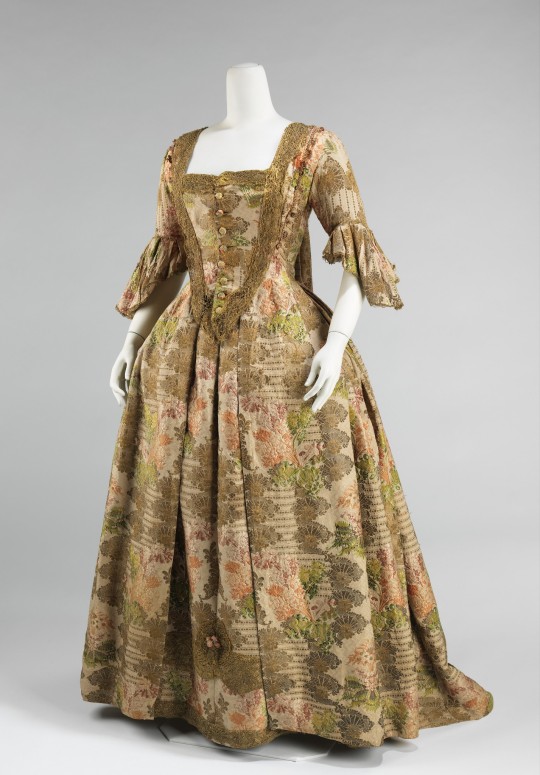

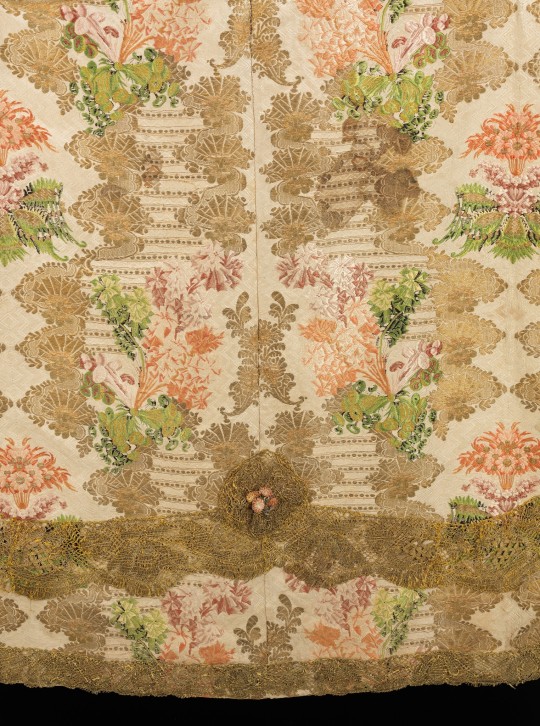
Title: Robe à la Française
Date: 1730–40
Culture: European
Medium: silk, metal
The MET Museum
This is an extraordinary example of weaving incorporating silver metallic threads in a very distinctive design. This textile was identified as an identical match to the textile of a gown worn to a Russian Imperial wedding in the in the 1730s.
Women with coquettish airs were imposing in robes à la française and robes à l'anglaise throughout the period between 1720 and 1780. The robe à la française was derived from the loose negligee sacque dress of the earlier part of the century, which was pleated from the shoulders at the front at the back. The silhouette, composed of a funnel-shaped bust feeding into wide rectangular skirts, was inspired by Spanish designs of the previous century and allowed for expansive amounts of textiles with delicate Rococo curvilinear decoration. The wide skirts, which were often open at the front to expose a highly decorated underskirt, were supported by panniers created from padding and hoops of different materials such as cane, baleen or metal. The robes à la française are renowned for the beauty of their textiles, the cut of the back employing box pleats and skirt decorations, known as robings, which showed endless imagination and variety.
74 notes
·
View notes
Text

THREAD: How to verify images online? Social media is awash with false or misleading images, some of which get millions of engagements. So, here's a simple guide on ways you can quickly check the veracity of an image you see on your social media feeds.
Reverse image search is the most fundamental part of content verification - the process of searching to find if, and when, an image has appeared on the internet before, and in what context. Google Lens, Yandex, TinEye and Bing are among the free tools that allow you to do this.

Lens is Google's excellent tool for checking online content. Here's a tweet by US conspiracy theorist Stew Peters claiming this cloud was seen in Turkey just before the recent earthquake. On Chrome, simply right-click on the image and select "search image with Google".

Google Lens will bring up a range of relevant results. If you click on the first link, you will see a Guardian report clarifying this was a lenticular cloud spotted in Bursa, Turkey, on 19 January - almost three weeks before the earthquake.


You've got your answer. But if you're keen to find the first source of the image, you can keep looking through Google Lens results for the earliest date. You'll find this Instagram post from 19 January. The user confirms she took the image at 8 o'clock that day.

Look for notable signs or landmarks in an image and use the crop feature to narrow down your search. In this image, those tower blocks in blue, yellow and green are a distinct feature. Crop the image on Lens and it'll quickly tell you that is Bogota, Colombia.

Google Lens results are not chronological, which means you sometimes have to scroll through several pages of results to find the earliest date. This image went viral days after the Russian invasion, claiming to show children seeing off Ukrainian troops. Let's check it on Lens.
Crop the image and click on "find image source". The first few pages of results are all from 2022 and 2023, but on page four you'll see the date 13 May 2016. Click on the link. You'll see the image on Flickr posted by Ukraine's Ministry of Defence, meaning it's an old photo.

Lens also helps you quickly translate text in another language, say a street or shop sign in an image, or spot text added to a doctored image. If you click on text in Lens for this alleged Zelensky image, it'll bring up fact-checks which show the photo has been manipulated.

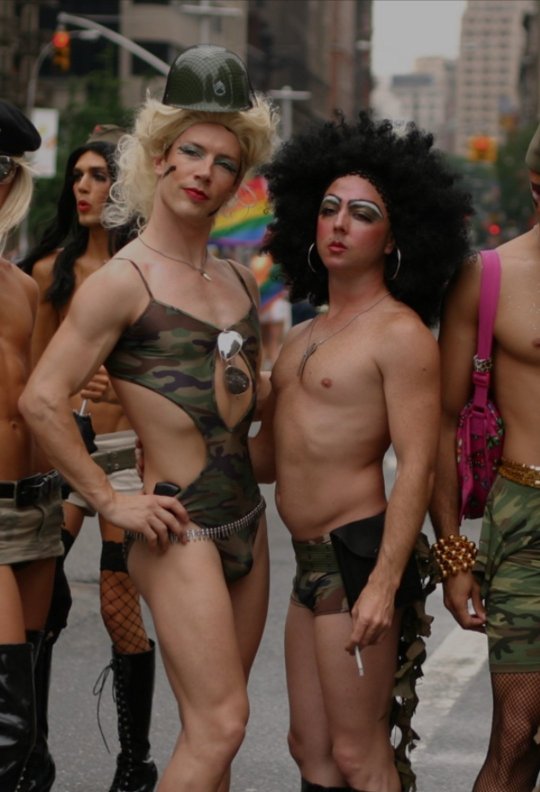
TinEye is another well-known, free reverse image search engine. While it may not be as comprehensive as Google Lens, TinEye has a very unique feature that I really appreciate: it allows you to filter results in a chronological order. https://tineye.com
Let's verify this viral image from last year, claiming to show a Nazi wedding in Ukraine. Upload the image to TinEye and you'll quickly see two things: The image seems to date back to at least 2016 or 2019, and that may not be the Ukrainian flag, but the Russian imperial flag.


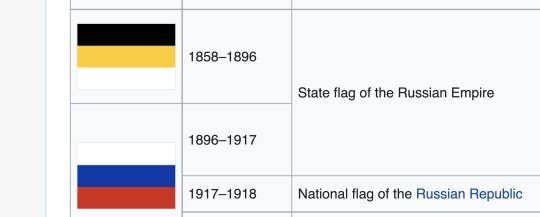
The fourth link leads us to a 2018 article that states not only has the flag been doctored, but also the image was taken in Novokuznetsk, Russia. If you reverse search that Lenin monument photo in the article, you will find it indeed matches the monument in the original image.


124 notes
·
View notes
Text


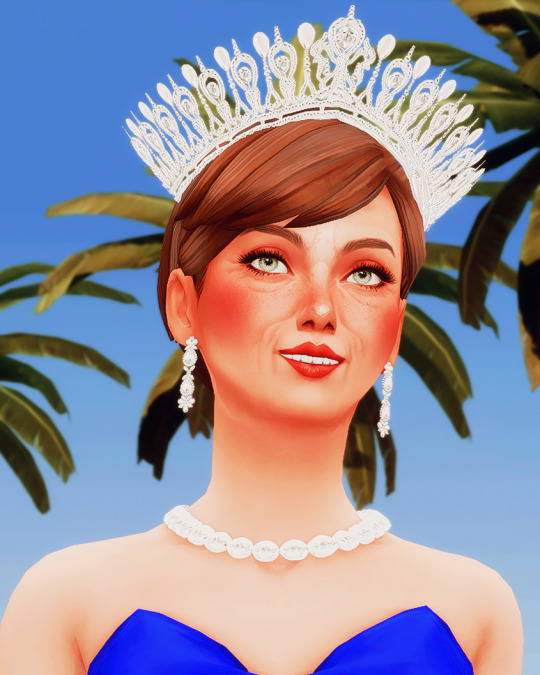
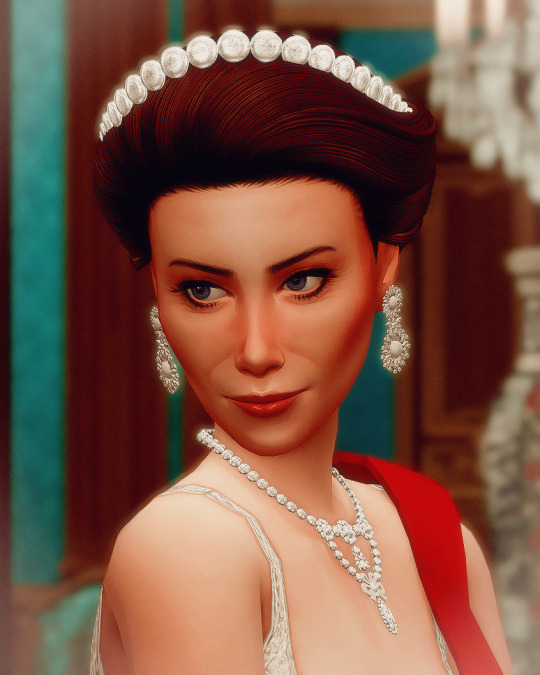

Sunderland's Royal Jewel Vault (10/∞) ♛
↬ Hesse Diamond Bandeau
This necklace-turned-tiara is one of the oldest in the royal vault. It originated in 1840 as a rivière of thirty-four brilliant diamonds. The diamonds were one of the hundreds of gifts the sixteen-year-old Princess Marie of Hesse received on the occasion of her wedding to Tsesarevich Alexander Nikolayevich, the future Emperor Alexander II of Russia.
Marie, immortalized as Emperess Maria Alexandrovna, had a secluded upbringing in Darmstadt and found the opulence of the Imperial Russian court overwhelming, but she slowly began to identify with her adopted country over the years. Photographs depict the Empress drenched in jewels, including the diamond rivière, which she wore as a necklace.
From here, the necklace's chain of inheritance gets a little muddy. Over the decades several of Empress Maria's daughters and daughters-in-law sported the necklace, yet there is no strong evidence of who owned the jewel following the Empress's death in 1880. Among others, two of the most notable wearers were Maria's successor Empress Maria Feodorovna (née Dagmar of Denmark) and her eldest daughter Queen Alexandra of Sunderland (née Grand Duchess Alexandra Alexandrovna). It is unclear which of Maria's female descendants owned the necklace, or if they had simply borrowed it for a time.
Either way, the necklace eventually landed in the jewelry box of Queen Alexandra's daughter-in-law, Matilda Mary, and it remained in Sunderland from that point onwards. Matilda was never photographed wearing the necklace, but she eventually bequeathed the mysterious jewel to Katherine Rothman, her granddaughter-in-law, when she became Princess of Danforth in 1943. Katherine mainly opted to wear twenty-seven of the diamonds set on a tiara frame. She favoured this improvised bandeau for trips to the Royal Alexandra Opera House both during and after her tenure as Queen. As a tiara, the diamonds were practical and lightweight, better for evenings out than formal state events.
The jewel's next wearer was Katherine's daughter-in-law Phyllis, who only ever wore the piece as a necklace, often pairing it with her Garland and Déléage Tiaras. The necklace was also worn without a tiara to many film premiers in the 80s and 90s. To this day these Hessian diamonds remain a popular staple of Phyllis's jewellery collection.
#warwick.jewels#ch: katherine#ch: phyllis#ts4#ts4 story#ts4 storytelling#ts4 edit#ts4 royal legacy#ts4 legacy#ts4 royalty#ts4 monarchy#ts4 screenshots#✨
47 notes
·
View notes
Text
Turkuzbek hcs because I don't give them enough love!!!!
Age: I was talking to a couple of friends about this! @peonycats believes turkey to be born around the years 900-1000 CE. meanwhile, uzbekistan would be born around the late 1200s, meaning that turkey's older than uzb by 300 years... 😔 rip my sexy milf uzb hcs...
History: they go wayy back. the Timurid Empire actually had a battle with the Ottoman Empire, largely out of the Ottoman Sultan Bayezid I's concern that the Timurids were expanding too far west. while the Ottomans were heading to the east, Timur's forces cut from behind and sieged Ankara, which started the Battle of Ankara(1402). the Timurid Empire won, also holding the title to being the only ones to capture an Ottoman Sultan in person in all of the Ottoman Empire's history. Not only that, but the Timurid Empire kinda caused a civil war in the Ottoman Empire due to the Sultan dying in captivity, causing all his sons to fight about who the legitimate heir was.
Nothing says teenage romance like causing a civil war in someone's empire and starting a record that was never broken for all 700 years of its history ❤️
(it's also said that allegedly the sultan was kept in a gold cage...)
turkey jokes about her bloodthirsty era, to which she tries smashing her face into his neck and slapping his shoulders "stop!!! I was 17 back then ok 😭😭" but will also say "ok but we caused a civil war at your place so"
after the Timurid Empire collapsed, the Ottomans and Uzbeks got along better. the Khwarazm and Bukhara khanates asked turkey to help them with the threat of russian expansion. and the Ottomans and uzbeks worked together to launch offensives against Iran in the late 1500s to early 1600s.
unfortunately i don't really have much for turkuzbek during the rule of imperial russia and the ussr as they barely interacted, and though turkey was the first nation to recognize uzbekistan's independence, relations soured during the first president's administration due to um. Driving turkish companies out because they had prayer mats in their offices 💀💀
BUT after the first president karimov died, the vice president mirziyoyev began to issue reforms and lifted bans on religious activity, causing a revival of islam in uzbekistan. turkey was all for it, so they began to get closer than ever. That's where they currently are in terms of relationships!
hcs:
THEY ARE LOSER HUSBAND X PRETTY WIFE THEY REALLY AREEE
you know when you have that trusted, dependable friend and one night at a sleepover they wanna tell you something and they confess to having a crush on the WORST person for them but they're head over heels in love? yeah that's uzbekistan 😔
she may be younger but if you didn't know it, you'd assume she's the older one based on maturity.
when they do get together, kazakhstan and kyrgyzstan are both...shocked. kazakhstan just thinks turkey's ego is massively inflated and that russia wouldn't appreciate their relationship getting closer, limiting russian economic support, whereas kyrgyzstan looks like one of those stick figures violence reaction images and kazakhstan has to hold him back
he's definitely the type of guy to slam his hand against the wall and corner her just to see her facial expression
he also calls her "Nargiz," a nickname of her name "Nargiza" which also alters her brain chemistry
though, i want to think that uzbekistan does try to make her move...just in private. idk how she'd do that use your imagination i guess?
even when they're in an established relationship, she's mostly affectionate in private. the most turkey's gonna get out of her in public is....h*nd h*lding or arm clutching but even then...she won't do that until they're married(turkuzbek wedding when???)
uzbekistan reading or scrolling through her phone after a long day of work and turkeys like "nargiz...pay attention to me......come on let's make tea......"
They give each other shoulder massages occasionally
when turkey catches uzbekistan reading he joins her
🇹🇷: hey stop turning the pages so quickly
🇺🇿: i can't stay on this page forever
one second he's talking about how manly of a man he is, next second he asks uzbekistan to cuddle him
they both love cats! and they occasionally have friendly fights about who's more hospitable
turkey and uzbekistan also argue about who did it wrong(uzbek osh vs turkish pilaf, and turkey gets upset at uzbekistan's pahlava because "it's a cheap ripoff")
i was reading about strengthening turkey uzbekistan relations and the article said something like "together, the uzbek and turkish presidents band together as hanafi against the wahabi-salafism sect" so imagining this whole convo:
🇸🇦 circa 2018: congratulations on getting your religious freedom back, uzbekistan! what is your next step moving forward?
🇺🇿: well actually i-
🇹🇷: she's with me lol
turkey has a weird obsession with mongolia and the casians' nomadic pasts
🇹🇷: HELLO MY TURKIC MONGOLIC NOMADIC ISLAMIC MARE MILK DRINKING HORSE RIDING STEPPE BROTHERS AND SISTERS
🇺🇿: im sorry sir this is a choyxona(tea house/restaurant)
though turkey is a fellow islamic nation and they do belong to the same sect as uzbeks do, uzbekistan is still a little stricter. lots of turkish dramas had scenes cut from the uzbek premiere, and some dramas were just...not broadcasted due to...spicy scenes(making out i guess??)
🇹🇷: awww, come on they cut out my favorite scene
🇺🇿: your what 😃🔪
they also get along because they have similar tastes in tea! might as well call them tea lovers
turkey prefers his tea with sugar, whereas uzbekistan just drinks it without.
russia looked down on her and the rest of the central asians because "they were in their ignorant peasant barbarian era before I came and changed everything for the better!!!!"
she also had to unhealthily bottle her feelings of nervousness, anxiety, and overwhelming anger as russia kept taking and taking from uzbekistan(things like cotton, and forcing the aral sea into irrigation, causing the 4th largest freshwater lake in the world to dry up), giving little back or nothing at all to uzbekistan
so one of my earliest turkuzbek hcs was that turkey helps her recover from nightmares by the ussr despite her not telling him what happened, and trying to get her to calm down with tea and desserts and that's when she realized she liked him so much.
saudi arabia initially didn't believe someone as "sensible and mature" as uzbekistan would get with turkey, until she herself confirmed it to him 😔 he mourns the loss of another normal person...
🇸🇦: Dear Diary, today we lost the land of Al Tirmidhi...Al Bukhari...our last bastion...to Turkey...now my allies are no more...
turkuzbek use scent as comfort. when one has to go back home after a meeting or event, the other spends the night hugging the pillow they slept with, or wearing a jacket or other article of clothing they left behind.
they steal each other's clothes for this reason!
back in like...2020 a turkish director partnered with the Uzbek Ministry of Culture and Sports to make the Mendirman Jaloliddin drama based on the last ruler of the Khwarazmian Empire before it fell to the Mongols. so anyways they're hyping up their country's actors before they go on set, and meanwhile all actors from both countries see how turkuzbek are and ship it as well lolol
and lastly: just because I'm also korean...soojin is their wingman lolol
This is all my brain could record, so if anyone has anything to add, please do not hesitate and add your hcs!
#hetalia#aph turkey#aph uzbekistan#hws turkey#hws uzbekistan#turkuzbek#sadik adnan#do i make uzb a main character? yeah#but its okay....i love nargiza#tokki writes
34 notes
·
View notes
Text

The 1997 Anastasia movie, while most likely being most people’s introduction to the Romanov Family and their history, was incredibly inaccurate.
Here are some of those inaccuracies
In the first opening moments, of the film we see the Dowager Empress Marie Feodorovna boarding the carriage to go to the ball. The footman greets her as Your Highness. In fact, the Dowager Empress addressed as Your Imperial Highness (there was a huge difference as Princess and Princesses were only entitled Your Highness.)
The Romanov Tercentennial was in fact 1913, not 1916.
In 1916, as the movie claims, Anastasia is 8. In fact, Anastasia was born in 1901, making her actually 15 at the time of the ball.
When we see Anastasia greet her grandmother at the ball, Marie Feodorovna wears a wedding ring on her left hand. In Russian Orthodoxy, the wedding band is worn on the right hand.
When the ‘evil’ Rasputin party-crashes the ball, Nicholas tells him he is a traitor. In the time Rasputin spent with the family, there was never any evidence that he betrayed them. He offered them his support, albeit for questionable reasons, but was only sent away for a short time by the Tsar under pressure from his ministers.
The raid of the Winter Palace occurred well into 1917, not 1916 as portrayed in the film. By this time, Nicholas had already abdicated (March of 1917) and they were imprisoned first at the Alexander Palace, then in the Governor’s mansion in Tobolsk, before being moved to the Ipatiev House in 1918, where they were ultimately murdered. The murder of the imperial family did not happen until two years after the ball in the film.
When Anastasia runs back to her room to retrieve her music box, we see the room to be rather “royal-looking” with a single large bed in the corner. Anastasia shared a room with her older sister Marie for all of their childhood, and their beds were in fact camp-beds; hard and not as luxurious as other royalty’s of the time.
Ten Years Later, 1926, Anya leaves the orphanage for a job at the fish market. When Anastasia reaches the fork in the road, the sign says Saint Petersburg. During the Great War, St. Petersburg was renamed Petrograd, a less German-sounding name. After communist leader Vladimir Lenin died in 1924, it became Leningrad, when it did not become Saint Petersburg again until 1991. Throughout the film this inaccuracy is repeated, most significantly in the song Rumor in Saint Petersburg. One would think even the peasants would be accustomed to a new name of their city after 10-15 years.
When Anastasia reaches the train station, the station guard wears the red cap with the Soviet crest. This crest wasn’t used in fact until the 1930s. It was only 1926.
A number of times, the peasants and Dmitri call her The Princess. In Russia, this would have been a great offense to her title, as Anastasia had always been, a Grand Duchess. The title Princess ranks significantly under Grand Duchess
Anya, is in fact a Russian nickname for Anna, not Anastasia. Anya was the name of her mother’s lady-in-waiting and close friend Anna Vyrubova. Anastasia’s nickname was Nastya, Nastia or shvibzik “imp”.
In 1926, the Catherine Palace was being used as a museum and its park area was open to the public, not quite as run down as in the film.
It wasn’t also the Imperial Family’s home, as suggested; they preferred the comfort and privacy of the Alexander Palace at Tsarskoe Selo, a little while outside the city.
When Olga, Tatiana and Marie come down to dance with their sister during the song, they all look to be around the same height. In truth, Anastasia was much shorter than her sisters. Tatiana was the tallest in the family, standing at around 5’9
The same mistake was made with Nicholas. When he and Alexandra come out of the portrait, he looks to be much taller than Alix; he, like his daughter, was actually rather short, only about 5’6, and stood around the same height as his wife.
When Bartok watches Vlad, Anastasia and Dmitri leave the ball room, he says All the Romanovs are dead. This simply wasn’t true. In 1919, around 30 Romanovs managed to escape via various methods, including the Dowager Empress Marie Feodorovna.
On the boat to France, Rasputin attempts to force Anya to jump off the side of the ship. She dreams she sees her father, sisters and brother playing in water. Nicholas calls her “Sunshine”, which was actually the nickname of her little brother, Alexei.
In this same dream, Alexei jumps from the top of the cliff down into the water. It was well-known that Alexei had a severe type 2 case of hemophilia, and there was no way Nicholas nor any of the sisters would have allowed him to make such a dangerous leap.
When the gang are journeying to Paris, they hope to meet the Dowager Empress. In 1926, Marie was actually living in Denmark, after the death of her beloved sister, Queen Alexandra of England the year before.
When Anastasia meets Sophie, she is asked how she likes her tea. Anastasia tells her she doesn’t like tea. But there have been many anecdotes of the real Anastasia drinking tea in the mornings and afternoons with her sisters and parents. (This of course may have changed as she aged).
When Dimitri refers to Anya and the Dowager Empress as ‘your grace’ this title is also incorrect. “Your Grace” was commonly used only amongst non-royal dukes and duchesses, and archbishops of the United kingdom.
When Vladimir announces ‘we have found the heir to the Russian throne’, this is completely innacurate. Even as the closest surviving member to the last Tsar, Anastasia would, sadly, have no right to the throne. There were around 30 dynastic members of the family surviving in 1926, and many available males. In Imperial Russia, the line of succession was strictly male-primogeniture; the eldest son would inherit the throne. In 1926, by law, this male would be the Grand Duke Cyril Vladimirovich.
The Dowager Empress could not have possibly had the means to offer a 10 million ruble reward for the return of her granddaughter. The Romanov fortune had all but disappeared and she largely relied on the charity of the English and Danish Royal Family.
The biggest inaccuracy, however, was that Anastasia survived. She, along with the rest of her family, were murdered by the Bolsheviks in 1918

#russian history#tsarist russia#anastasia romanov#anastasia 1997#film history#historical inaccuracies
15 notes
·
View notes
Note
yoyoo can u write something about timmy and the reader doing that wired autocomplete video and they’re secretly dating thanks hehe
ofc!! so sorry this took so long but i wanted to really write it when it felt right and i could do it justice <33 hope u like it
i imagined timmy and reader would star in a film ver of the (let others wage war) series not exactly but the historical couple it was based on with a happy ending yk so please enjoy!


“Hey guys, I’m Timothee Chalamet.”
“”And I’m (Y/N) (L/N) - and this is our Wired autocomplete video.”
“(Y/N) and I will be answering questions that you have been searching about us on the internet.”
Sitting next to him in identical folding chairs, you were both dressed more semi-casual than you did at the beginning of your promotional tour for your new movie.
A period piece about doomed royal lovers, and the second chance they were given for their happy ending - true or not, it was an instant hit not only among niche filmgoers but the general public got word of the Oscar buzz that surrounded your movie.
Playing the young Dowager Tsarina Maria Feodorovna, mother of the doomed, tragic Tsar Nicholas II whose family perished under Bolshevik imprisonment. Exploring her rags to riches youth, from an impoverished fourth daughter of a cadet, untitled and penniless soldier prince to daughter of the King of Denmark.
Timothee played your handsome, sensitive and intelligent young prince and heir to the throne - Tsesarevich Nicholas Alexandrovich, successor to the Imperial Russian throne. His character fell in love with your character from a portrait before meeting her, head over heels as your character reciprocated that before his untimely death months before the wedding could occur.
As the older Tsarina reminisced on his death anniversary fondly long after his death, your character wakes up back in her youth, unmarried and hours before the arrival of the Russian royal family to visit the Danish royal court.
Most of moviegoers were familiar with your character as the grandma of the infamous Anastasia, mythically believed to have survived the assault on her family, so they were impressed and thoroughly interested in this deep dive of an unfamiliar side of her youth, destined with thrills, intrigue, gorgeous gowns, balls, romance and unspeakable wealth and opulence.
Mere days before the announcement of next year’s Oscar nominations, the film and your respective PR teams amped up your promotions under the public eye to really campaign that both of you would helm the film’s nominations, as murmurs erupted around film critics that all four acting categories from your film would be top runners for the season.
Your characters were clearly the heart of the film, heavily building up your chemistry with him that was evident even from the first chemistry test. If only they knew, you both started dating shortly after rehearsals concluded and you were well into filming.
“Does Timothee Chalamet __” You pick up a board underneath your chair, craning your neck to read it before peeling off the first search terms’ sticker.
“Does Timothee Chalamet read - god I hope so.” Timmy reads from the board, mocking how offended he was and you couldn’t help but giggle along with him.
“Well if you watched the film, he sure had to read a lot to know the long lines he had for the character.” You try to defend him with a joking tone.
“Alright next up, Does Timothee Chalamet write songs - Yes I’ve tried writing songs before without too much success clearly, which is why I’m here.” He comments snarkily, shrugging his shoulders.
“I really like Statistics and oh oh- Hell’s Kitchen is so underrated. Please listen to his soundcloud -hey!” Excitedly jumping up on your seat, he dives in trying to yank the board off your arms and puts his palm over your mouth so you’d stop talking, to no avail.
“Hey- stop that! I don’t know what you’re talking about.” Timmy can’t help but giggle at how fond he is of you and how you aren’t really making fun of him, but trying to hype him up about a time he doesn’t want to remember.
“ What does Timothee Chalamet do? That’s a great question. I wonder the same thing.” You banter with him playfully as he looks at you incredulously with a quirked eyebrow.
“We clearly play dress up and dance - And pretend to fall in love.” He speaks nonchalantly, though you don’t miss the pronounced intonation on ‘pretend’ that you’re sure won’t be noticed by anyone, other than the shippers vigilantly watching both your every move.
“He keeps stepping on my feet, on purpose, during the waltz scenes. It was better than the rehearsals at least, but I had lots of fun with this guy. Couldn’t have a better Nixa to my Minnie.” You get all sentimental, brushing your knees against his as the crew members coo in penchant for you two.
Sharing a knowing look, you both break out into laughter, knowing you’ve both made plans towards moving in an apartment together and adopt a dog or cat soon, but for now it was your little secret. The private world only you two existed, and an oath unknown to the public eye.
You didn’t want to wave around your relationship to get in the way of work, and draw the boundaries between your personal and work lives. Yet when you kiss him on the lips passionately as the crowds cheered when you were announced Best Actress, the internet went crazy with the revelation.
Maybe they knew, maybe they had an inclination - but at least you had the first year all to yourselves, sans your immediate friends and family. Both coming home with golden statues that night, you couldn’t ask for more.
Your characters were tragically separated by sickness, and had their chance in being happily in love together. Your film indulges in an utopian timeline where everything went as planned, and the audiences loved it. So - maybe life imitates art?
#timothee chalamet imagines#timothee chalamet x reader#timothee chalamet scenarios#timothee chalamet#requests
370 notes
·
View notes
Text
Essay Recommendations
Divination, Fate Manipulation, and Protective Knowledge in and around The Wedding of the Duke of Zhou and Peach Blossom Girl, a Popular Myth of Late Imperial China- Vincent Durand-Dastès
Meaning, Reception, and the Use of Classics: Theoretical Considerations in a Chinese Context - Longxi Zhang
Escapism as a Result of Human Physical Limits- Elizaveta Basharova
The Cult of Donna Tartt: Themes and Strategies in The Secret History - Ana Rita Catalão Guedes
Never Do That to a Book - Anne Fadiman*
Affecting Anger: Ideologies of Community Mobilisation in Early Hindi Novel - Rohan Chauhan*
Why I Write - George Orwell*
The Feminist Critique of Art History - Thalia Gouma-Peterson, Patricia Mathews
In Plato's Cave - Susan Sontag
*On reproduction of art (Chapter 1, Ways of Seeing) - John Berger
*On nudity and women in art (Chapter 3, Ways of Seeing) - John Berger*
Russian Studies of Chinese Traditional Drama and Storytelling Literature: An Overview- Rostislav Berezkin
#dark academia#romantic academic#academia#literature#classic#books & libraries#books#essay#academic essay#writing#reading#Aesthetic#the secret history#dark acadamia aesthetic#george orwell#plato#booklr#book reccomendation
58 notes
·
View notes
Text
Józef Poniatowski’s family album
Part III. Maternal relatives
Because prince Józef's mother wasn't Polish, the information I have about her family is much less in comparison with the Poniatowskis. Nevertheless, there is still something on the topic I can share with you.
As I wrote before, prince Józef got his first name in honor of an uncle, his mother's brother. Et voila - here he is:
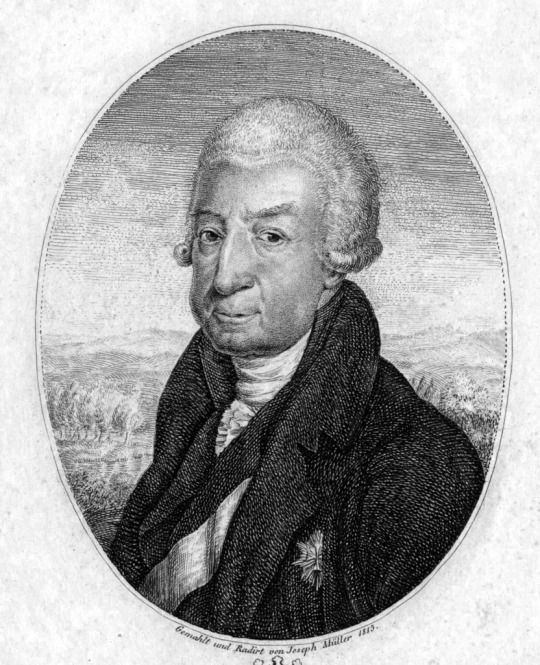
Filip Josef Count Kinský of Vchynice and Tetovo
Being born in 1741 he was a year younger that Teresa. And apart from those two among the sibling there were also the older brother Franz Ferdinand and the younger sister Maria Anna.
As stated in the German Wikipedia (there is no information about him in English), he chose a military career resigning in 1783 from the imperial army with the rank of major general.
His personal life, however, didn't look like a happy one. According to a family contract, he was engaged to his cousin Marie Auguste but she died in 1763 not coming of age. In 1787 Filip Josef married the Countess Maria Theresia von Dietrichstein who was 17 years younger than him. But she left him shortly after the wedding and next year the marriage was annulled.
So it look like the closest person to Filip Josef was his sister Teresa, prince Józef's mother. As stated in the article, she often visited him in Chraustowitz Castle, a residence he inherited from their mother. In Teres's honor, Filip Josef even built a small hunting castle Theresienlust (of which only the ruins remain).
One more interesting fact to add here is that the mother of the Kinskys siblings was of Italian origins, born Maria Theresia Capece, marquise di Rofrano.
Who else of the Kinskys is IMO worth to mention it is prince Józef's third cousin, Ferdinand, the 5th Prince Kinsky of Wchinitz and Tettauv:

Lithograph by Josef Kriehuber
Doesn't he look a little bit like prince Józef? ;)
But Ferdinand was 18 years younger than Poniatowski, he was in 1781, in Vienna (the latter fact makes probable prince Józef, who was living in Vienna that time, knew about such a cousin of his).
And Ferdinand Kinsky also chose a military carrier, he took part in the war of 1809; however, his regiment wasn’t among the ones which invaded the Duchy of Warsaw, captain Kinsky’s battalion fought the French in the battles of Regensburg, Aspern and Wagram.
I didn’t find any information whether Ferdinand Kinsky participated in 1812 in Napoleon’s Russian campaign, but he found his death in that very year. While inspecting his estates in Weltrus he fell from his horse and died shortly afterwards as a result of the accident.
Also prince Józef might have known two brothers, Josef and Franz Josef Kinskis, who also were his third cousins and as well served in the Austrian Army (being a thirty years older than Poniatowski they might have provided some protection over him when he was starting his military career).
In addition, there was a Dutch line of the Kinskys family, from whose representatives Franz Friedrich was a contemporary of prince Józef but I have very much doubts whether Poniatowski knew those people.
8 notes
·
View notes
Text
Irina Alexandrovna Romanova (1895 -1970)
When Grand Duke Alexander Mikhailovich married Grand Duchess Xenia Alexandrovna (sister of the then Tsarevich Nicholas Alexandrovich), he was marrying one of the best matches in Europe: Xenia was the daughter of the Tzar Alexander III and the sister of the future Tzar Nicholas II. She had been in love with "Sandro," her second cousin, since childhood (and he saw no reason to discourage her affections, of course)
Sandro and Xenia had seven children. Irina was their first child and only daughter. This beautiful, quiet, delicate child was the first grandchild of Alexander III (who died the year before she was born) and would be the only biological niece of Tzar Nicholas II.

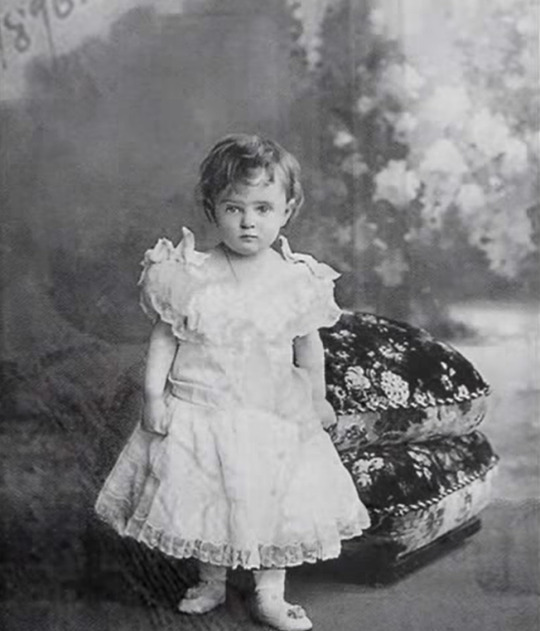
During the first few years of their respective marriages, the Tzar and Empress Alexandra and Grand Duke Alexander and Grand Duchess Xenia spent a lot of time together, and their daughters Olga and Tatiana, and Irina being very close in age, spent a lot of time together and developed a relationship. Distance would later grow between the couples and the children.
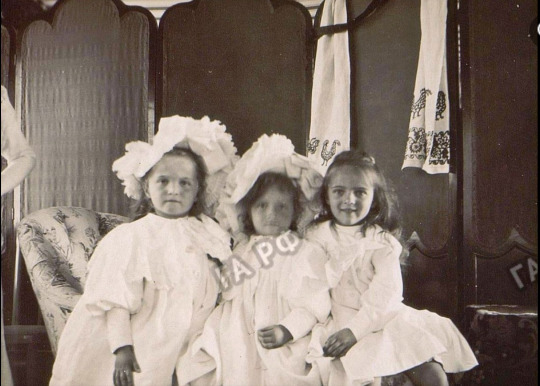
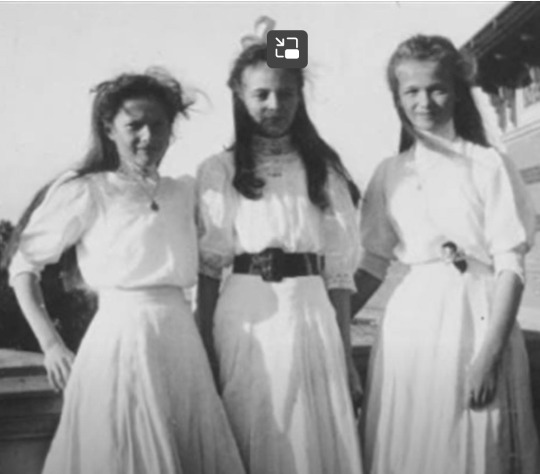
By the time Xenia was pregnant with her seventh child, her marriage to Sandro had gone sour. Sandro had fallen in love with a French/Spanish woman and was having an affair with her. Subsequently, Xenia started an affair of her own. Some sources say that they managed to keep their marital problems from their children; others that their quarrels might have had something to do with Irina's decision to marry Prince Felix Yusupov when he asked.


Felix was handsome, extremely smart, and one of the richest men in Russia, but he had a reputation. Irina accepted him as a bridegroom regardless of her parents' misgivings. Felix had a wild youth which seemed to include affairs with men and women. He enjoyed dressing as a woman and wearing his mother's jewels; apparently, he even caught Edward VII's eye at some point. When the Dowager Empress Maria Feodorovna talked with him about this behavior before his marriage to Irina, he did not deny it. Still, he said that his wild days were over, and he was very much in love with Irina.



Irina had no qualms about signing away succession rights for their future progeny when she married Felix, who was not royal (their marriage was morganatic.) She married him wearing a veil that had belonged to Marie Antoinette. Both looked beautiful. Their wedding was the last grand happening (1000 guests) before the Great War.

Felix and Irina were out of Russia when WWI started and had difficulty passing through Germany to return to Russia.
The Yusupovs settled in a section of Felix's parents' Moika Palace. Felix and Irina had one daughter (whom they named Irina but called "Bebe") and helped the war effort in Russia by opening two hospitals and a sanatorium in their Crimean state of Koreiz.
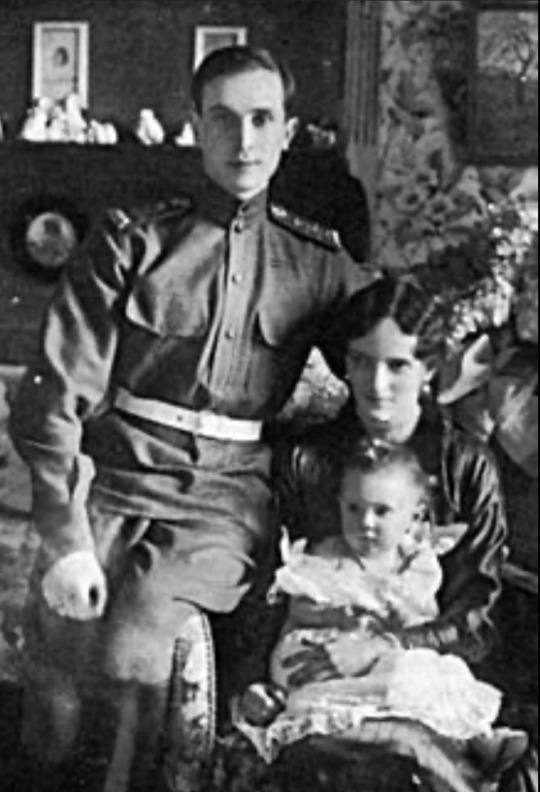
Felix would go on to kill Rasputin (he was banished to Koreiz by the Tzar) in a misguided effort to help the dynasty survive. As things in Russia became worse. A group of members of the Imperial Family, including the Dowager Empress, Irina's parents and brothers, and several Grand Dukes and their families, avoided being imprisoned and murdered by seeking shelter in Crimea. The Russians held them, prisoner until the Treaty of Brest-Livtosk was signed. Interestingly enough, the Germans liberated them. They left Russia in a warship sent by England to rescue the Dowager Empress.
They lived in an apartment Felix had in London; they had also smuggled out paintings and jewelry. There was a car they had not used in years waiting in a garage in Paris. The couple was extremely generous to the Russian Community and gave a lot to the exiles in need. They eventually bought a mansion in Paris and opened a couture house in Paris, which was very successful for a few years.


Felix and Irina lead an expensive lifestyle, and their couture business went bankrupt (after significant success.) By 1934, as luck would have it, Metro-Goldwyn-Mayer released a film named "Rasputin and the Empress." Felix sued the company for slandering Irina and won the lawsuit. He also released two books which did very well.
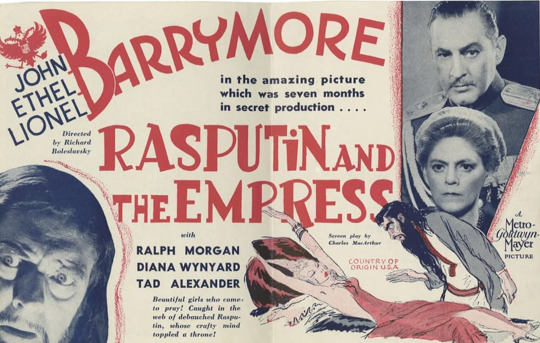
After this, the coupled lived a quiet life (for them), supporting young artists and attending various functions of the Russian emigre community.
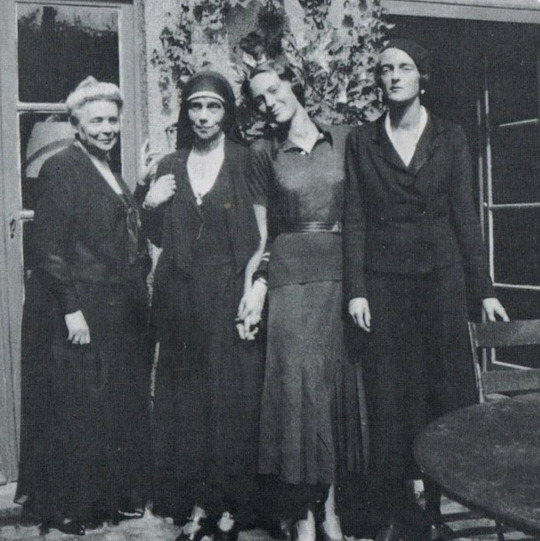

Irina remained close to all her relatives and helped them whenever she could. Her father, Grand Duke Alexander Mikhailovich, died in her arms.
Felix's and Irina's marriage turned out to be a great success. They were married and lived together, supporting and caring for each other for over fifty years. When Felix died in 1967, Irina was grief-stricken. She died three years later.
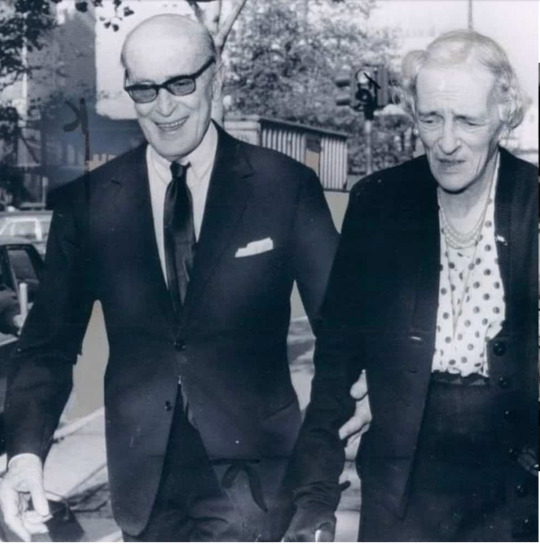

#russian history#romanov dynasty#Imperial russia#NAOTMA#Grand Duchess Xenia Alexandrovna#Princess Irina Alexandrovna#Prince Felix Yousupov#IRFE#Grand Duke Alexander Mikhailovich
90 notes
·
View notes
Text
Social media is awash with false or misleading images, some of which get millions of engagements.
So, here's a simple guide on ways you can quickly check the veracity of an image you see on your social media feeds.
Reverse image search is the most fundamental part of content verification - the process of searching to find if, and when, an image has appeared on the internet before, and in what context.
Google Lens, Yandex, TinEye and Bing are among the free tools that allow you to do this.
Lens is Google's excellent tool for checking online content.
Here's a tweet by US conspiracy theorist Stew Peters claiming this cloud was seen in Turkey just before the recent earthquake.
On Chrome, simply right-click on the image and select "search image with Google".
Google Lens will bring up a range of relevant results.
If you click on the first link, you will see a Guardian report clarifying this was a lenticular cloud spotted in Bursa, Turkey, on 19 January - almost three weeks before the earthquake.
[I]f you're keen to find the first source of the image, you can keep looking through Google Lens results for the earliest date. [...] Google Lens results are not chronological, which means you sometimes have to scroll through several pages of results to find the earliest date.
...
Let's verify this viral image from last year, claiming to show a Nazi wedding in Ukraine.
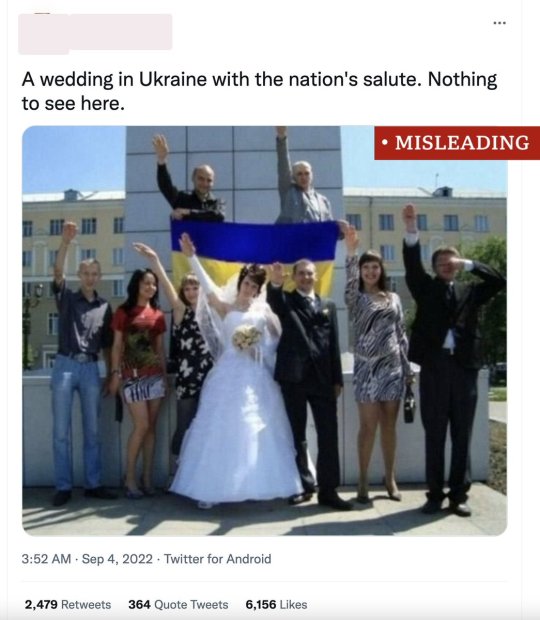
Upload the image to TinEye and you'll quickly see two things:
The image seems to date back to at least 2016 or 2019, and that may not be the Ukrainian flag, but the Russian imperial flag.
The fourth link leads us to a 2018 article that states not only has the flag been doctored, but also the image was taken in Novokuznetsk, Russia.
If you reverse search that Lenin monument photo in the article, you will find it indeed matches the monument in the original image.
6 notes
·
View notes